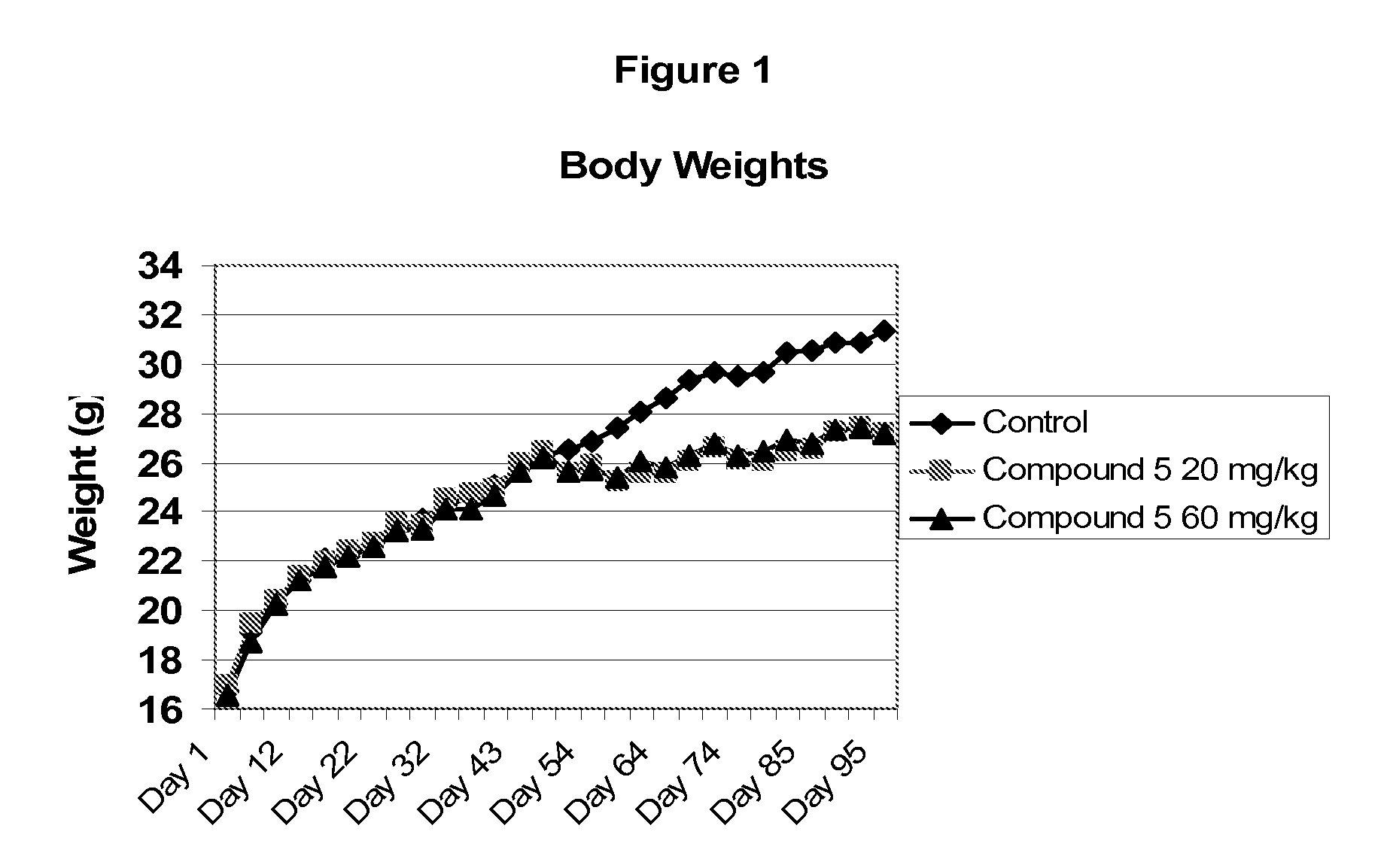Soluble epoxide hydrolase inhibitors for treatment of metabolic syndrome and related disorders
a technology of soluble epoxide hydrolase and metabolic syndrome, which is applied in the direction of biocide, drug composition, and metabolic syndrome, can solve the problems of complex biologic mechanisms between insulin resistance and metabolic risk factors, increased risk of heart attack, stroke, and exacerbate other conditions present in patients, and achieves reduced high-density lipoproteins, reduced blood pressure, and reduced risk of strok
- Summary
- Abstract
- Description
- Claims
- Application Information
AI Technical Summary
Benefits of technology
Problems solved by technology
Method used
Image
Examples
example 1
Synthesis of 1-[1-(acetyl)piperidin-4-yl]-3-(4-trifluoromethylphenyl)urea (Compound 3)
Preparation of tert-butyl 4-aminopiperidine-1-carboxylate
[0342]4-Aminopiperidine (5.0 g, 50 mmol, 1 eq.) was added to a solution of benzaldehyde (5.1 mL, 50 mmol, 1 eq.) in toluene (130 mL) in a 250 mL 3-necked flask fitted with a Dean-Stark trap and a condenser. A nitrogen line was connected to the top of the condenser, and the reaction was refluxed for 3 hours, during which time, water was seen to condense in the Dean-Stark trap. The reaction was cooled to room temperature and Boc anhydride (5.8 mL, 50 mmol, 1 eq.) was added over 5 minutes. The reaction was stirred over night under a blanket of N2. The solvent was then removed under vacuum and NaHSO4 (1M in water, 50 mL) was added to the residue. The resulting mixture was stirred vigorously for 2 hours before partitioned between diethyl ether (250 mL) and water (250 mL). The aqueous layer was separated, washed with diethyl ether (3×150 mL) and ba...
example 2
Preparation of 1-[1-(methylsulfonyl)piperidin-4-yl]-3-(4-trifluoromethylphenyl)urea (Compound 4)
[0347]To a solution of 1-(piperidin-4-yl)-3-(4-(trifluoromethyl)phenyl)urea (10.8 g, 37.6 mmol) (prepared as above) in DCM (150 mL) cooled with an ice water bath was added sequentially Et3N (15.7 mL, 113 mmol) and methanesulfonyl chloride (4.37 mL, 56.4 mmol). The reaction was stirred at room temperature for 18 hours. Water (200 mL) was added and the mixture was stirred for another 18 hours. The resulting precipitate was collected by filtration, washed with water (2×50 mL), and dried for 18 hours to give the titled product (3.6 g). The supernatant from the filtration was phase separated. The organic layer was dried over Na2SO4, filtered, and concentrated to give an additional 4.0 g of product. The combined crude product (7.6 g) was recrystallized from EtOAc to give the pure product as a white solid (3.15 g, 23%). HPLC purity 93.8%; MS: 366 [M+H]+;
[0348]1H NMR (300 MHz, CDCl3+DMSO-d6): δ 8...
example 3
Preparation of 1-[3-(morpholino-4-carbonyl)phenyl]-3-(4-trifluoromethylphenyl)urea (Compound 1)
[0349]A solution of 4-trifluoromethylphenyl isocyanate (350 mg, 1.87 mmol) and 3-amino-benzoic acid (450 mg, 3.28 mmol) in DMF (10 mL) was warmed at 70° C. overnight. The reaction was monitored by TLC. The reaction mixture was cooled to room temperature and water (5 mL) and 1 N aq. HCl (5 mL) was added with ice bath cooling and stirred for 1 hour. The resulting solid was filtered, washed with water, hexane and dried in a vacuum oven. The crude product was recrystallized from acetone / hexane to afford 310 mg (51%) of product as a white solid. m.p. 271-274.
[0350]To a solution of the above product (254 mg, 0.782 mmol), morpholine (150 mg, 1.72 mmol), and DMAP (102 mg, 0.831 mmol) in DCM (15 mL) was added N-[(dimethylamino)propyl]-N′-ethylcarbodiimide hydrochloride (190 mg, 0.991 mmol) at room temperature. The reaction mixture was stirred overnight. The reaction mixture was concentrated and the...
PUM
| Property | Measurement | Unit |
|---|---|---|
| density | aaaaa | aaaaa |
| blood pressure | aaaaa | aaaaa |
| covalent | aaaaa | aaaaa |
Abstract
Description
Claims
Application Information
 Login to View More
Login to View More - R&D
- Intellectual Property
- Life Sciences
- Materials
- Tech Scout
- Unparalleled Data Quality
- Higher Quality Content
- 60% Fewer Hallucinations
Browse by: Latest US Patents, China's latest patents, Technical Efficacy Thesaurus, Application Domain, Technology Topic, Popular Technical Reports.
© 2025 PatSnap. All rights reserved.Legal|Privacy policy|Modern Slavery Act Transparency Statement|Sitemap|About US| Contact US: help@patsnap.com



